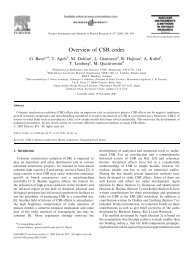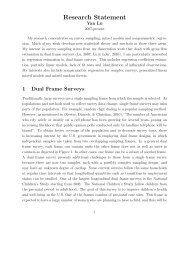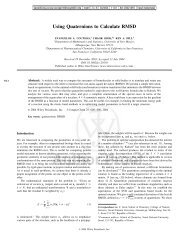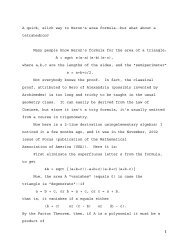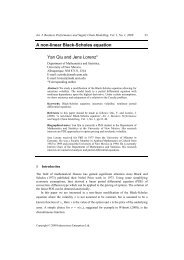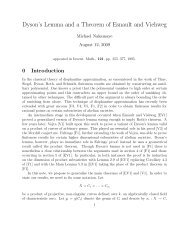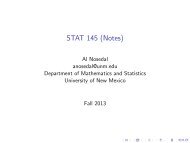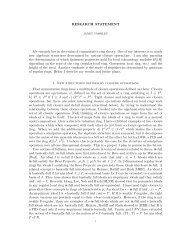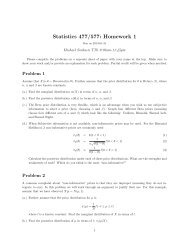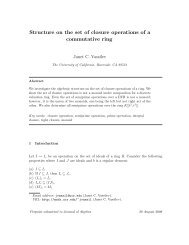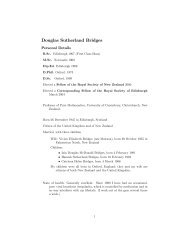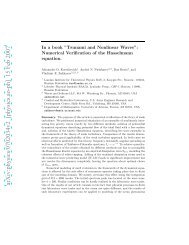OEO Office of Equal Opportunity - Department of Mathematics and ...
OEO Office of Equal Opportunity - Department of Mathematics and ...
OEO Office of Equal Opportunity - Department of Mathematics and ...
You also want an ePaper? Increase the reach of your titles
YUMPU automatically turns print PDFs into web optimized ePapers that Google loves.
198 ARTS AND SCIENCES<br />
the coordinator in order to construct an appropriate program<br />
<strong>of</strong> study. Courses not listed below may sometimes be taken,<br />
subject to approval <strong>of</strong> program coordinator.<br />
I. The Introduction to World Cultures <strong>and</strong><br />
Critical Theory–9 credits<br />
9 credits from the following courses: COMP 223, COMP 224,<br />
ENGL 292, <strong>and</strong> ENGL 293<br />
II. Cultures <strong>and</strong> Literatures–9 credits<br />
Literature, culture <strong>and</strong> theory courses at the 300-level or<br />
above <strong>of</strong>fered by the <strong>Department</strong> <strong>of</strong> Foreign Languages <strong>and</strong><br />
Literatures <strong>and</strong> programs <strong>and</strong> departments affiliated with<br />
the Program in Comparative Literature <strong>and</strong> Cultural Studies.<br />
These courses must broaden a student’s knowledge <strong>of</strong> the<br />
forms <strong>of</strong> representation <strong>and</strong> cultural production that emerge<br />
from specific historical periods <strong>and</strong> places.<br />
III. The Concentration--15 credits<br />
Students choose a concentration in either Cultural Studies or<br />
Comparative Literature.<br />
A. The Cultural Studies Concentration:<br />
Courses chosen in this concentration will normally focus<br />
on critical <strong>and</strong> cultural theory <strong>and</strong> will provide students<br />
with tools for analyzing literary <strong>and</strong> cultural problems<br />
while broadening their knowledge <strong>of</strong> world cultures <strong>and</strong><br />
forms <strong>of</strong> representation in different media.<br />
–or–<br />
B. The Comparative Literature Concentration: Courses<br />
chosen in this concentration will be divided between<br />
literatures in two different languages (one <strong>of</strong> which<br />
may be English or American Literature). Courses meeting<br />
the requirement for a national literature that is not<br />
English or American will not normally be in translation.<br />
Courses may include studies in theory, history, film <strong>and</strong><br />
the arts, as well as in literary texts.<br />
Second Major Study Requirements<br />
Students complete 27 credits <strong>of</strong> course work, as described<br />
below. For specific courses in categories II <strong>and</strong> III, see corresponding<br />
categories in the major.<br />
I. 9 credits from the following courses: COMP 223, COMP<br />
224, ENGL 292, <strong>and</strong> ENGL 293.<br />
II. 6 credits in literature, culture <strong>and</strong> theory courses.<br />
III. 12 credits in cultural studies or comparative literature.<br />
Minor Study Requirements<br />
Students complete 21 credit credits <strong>of</strong> course work, as<br />
described below. Normally, courses taken in a student’s major<br />
cannot be counted toward the minor. For specific courses in<br />
category III, see category III in the major.<br />
I. 6 credits from the following courses: COMP 223, COMP<br />
224, ENGL 292, <strong>and</strong> ENGL 293.<br />
II. 6 credits taken in the following courses: COMP 330<br />
– 340, 432, 480.<br />
III. 9 credits in cultural studies or comparative literature, as<br />
described above.<br />
Graduate M.A. Program<br />
Comparative Literature <strong>and</strong> Cultural Studies is an interdisciplinary<br />
M.A. program administered by the coordinator <strong>and</strong> the<br />
Advisory Committee (see above).<br />
The Master <strong>of</strong> Arts is <strong>of</strong>fered as an interdepartmental program<br />
that may be completed by fulfilling requirements under Plan<br />
I or Plan II. Students following Plan I will take 25 credits <strong>of</strong><br />
graduate course work <strong>and</strong> additional 6 credits <strong>of</strong> thesis work.<br />
Students following Plan II will take 31 credits <strong>of</strong> graduate<br />
course work. Students following Plan I or Plan II will complete<br />
Foreign Languages <strong>and</strong> Literatures examination requirements<br />
for the degree by their final semester <strong>of</strong> study. The<br />
requirement for second-language pr<strong>of</strong>iciency for students<br />
in the Cultural Studies Concentration may be satisfied after<br />
a student has been admitted to the program by taking the<br />
first two semesters <strong>of</strong> a language sequence or by passing a<br />
pr<strong>of</strong>iciency examination. Because this is an interdisciplinary<br />
program <strong>of</strong>fered by the <strong>Department</strong> <strong>of</strong> Foreign Languages<br />
<strong>and</strong> Literatures in conjunction with affiliated departments <strong>and</strong><br />
programs, students must work closely with a CL/CS coordinator<br />
to construct an appropriate plan <strong>of</strong> study. The coordinator<br />
will determine which courses outside <strong>of</strong> Foreign Languages<br />
<strong>and</strong> Literatures may be applied to the M.A. degree in consultation<br />
with a student’s committee on studies. Only 3 credits<br />
<strong>of</strong> problems courses may be counted toward the M.A. under<br />
Plan I <strong>and</strong> only 6 credits under Plan II.<br />
I. The Core (7 credits)<br />
COMP 500; MLNG 501 (1 credit); one course in theory <strong>and</strong><br />
criticism: COMP 580, FREN 520, 580, 582, 610, 611; GRMN<br />
555; ENGL 510, 511, 590; AMST 516, 517, 518, 525, 535,<br />
545, 554, 555; CJ 500, 501; ANTH 536, 547; SOC 500, 512,<br />
513, 514.<br />
—plus—<br />
II. The Concentration:<br />
A. The Comparative Literature Concentration—Plan I (18<br />
credits + 6 thesis credits <strong>of</strong> COMP 599); Plan II (24<br />
credits)<br />
Students will split these credits evenly between literatures<br />
from two different languages (one <strong>of</strong> which may<br />
be a literature in English): FREN 501, 502, 512, 520,<br />
522, 524, 532, 542, 552, 570, 580, 582, 584, 585, 586,<br />
588, 600, 610, 611; GRMN 549, 550, 552, 553, 555,<br />
556, 581, 585; GREK 301, 302; LATN 303, 304, 351,<br />
352, 503; PORT 514, 515, 516, 517, 521, 557, 558;<br />
SPAN 504, 515, 519, 520, 522, 523, 525, 526, 529, 629,<br />
531, 532, 536, 631, 633, 639, 578, 579, 679; ENGL<br />
545, 547, 548, 549, 550, 551, 552, 553, 554, 555, 556,<br />
557, 558, 559, 560, 561, 562, 563, 564, 565, 566, 568,<br />
570, 571, 572, 573, 574, 579, 580, 581, 582, 583, 586,<br />
587; AMST 508, 540, 541, 542, 550, 552, 556, 557,<br />
558, 559, 560, 562, 563, 564, 565.<br />
—or—<br />
B. The Cultural Studies Concentration—Plan I (18 credits<br />
+ 6 thesis credits <strong>of</strong> COMP 599); Plan II (24 credits)<br />
Students will take half <strong>of</strong> these credits in cultural criticism<br />
<strong>and</strong> theory: COMP 580, FREN 520, 580, 582, 610,<br />
611; GRMN 555; ENGL 510, 511, 590; AMST 516, 517,<br />
518, 525, 535, 545, 554, 555; CJ 500. 501; ANTH 536,<br />
547; SOC 500, 512, 513, 514. They will take a second<br />
half in an interdisciplinary field defined with advisement<br />
from the committee on studies drawing on courses<br />
above the 500-level in American Studies, Anthropology,<br />
History, Fine Arts, Communications <strong>and</strong> Journalism,<br />
Political Science, Linguistics, Philosophy, Law, Foreign<br />
Languages <strong>and</strong> Literatures, Spanish <strong>and</strong> Portuguese,<br />
English, <strong>and</strong> Media Arts.<br />
—or—<br />
C. The Classics Concentration—Plan I (18 credits + 6<br />
thesis credits <strong>of</strong> COMP 599); Plan II (24 credits)<br />
Students under Plan I will take 12 credits in either<br />
Greek or Latin above the 300-level. They will take 6<br />
credits in courses about the classical world <strong>and</strong> its<br />
legacy or 6 credits in theory <strong>and</strong> criticism. Students<br />
under Plan II will take 15 credits in either Greek or Latin<br />
UNM CATALOG 2006–2007 Symbols, page 611.



